
by Rick O'Connor | Mar 21, 2015
What many have been waiting for… spring is here! HAPPY EQUINOX EVERYONE!
Today’s photoperiod will be 12 hours of daylight and 12 hours of darkness – equinox. Many cultures around the world celebrate this and many ancient cultures built great structures to celebrate the event. It is also a time that many forms of plants and wildlife on our barrier islands begin to awaken and become more active.

The spring equinox sunrise over Santa Rosa Island, March 21
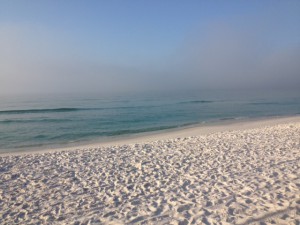
Fog rolling over the Gulf of Mexico in the early morning.
You might remember in our January edition of this series we showed the low angle of the sun over the Gulf on a January morning. Here we see the sunrise is slightly higher. The equinox is a special time of year for many. Moving form the cooler winter temperatures to the milder spring we typically will find water vapor condensing near the earth’s surface forming fog. This first morning of spring was no different. As the day warmed quickly the fog “burned off” producing a fabulous sunny warm day for all.

The spread toes of the opossum make identifying this track easier.
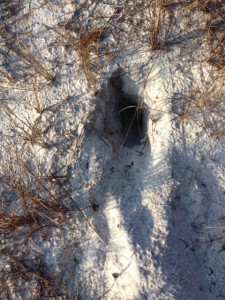
Armadillo digs are evidence of night time insect raid by this animal.
We did not see any live mammals moving across the dune fields but we did see plenty of tracks of the presence. We could identify at least 4 different types of creatures moving across the dune faces with all sorts of crossing patterns indicating these longer warner days have them moving. After lying dormant during the colder months it is time to find food, and for some, mates. Many of the mammals on the barrier islands are nocturnal in habit but may be spotted in the early mornings or late afternoons.

Tracks of an ATV moving across a dune face near the sound side of the island.

The mysterious unknown drag.
We were not sure whether this ATV track was from an official vehicle checking on something or from a local who did not want to walk all the way to the sound, but we would remind everyone that vehicles such as these are not allowed on the dunes and can cause much damage. I have been hiking this area for years and this is the first vehicle track I have seen in a long time. If you are interested in fishing the sound and can not access by boat, there are other locations on the island where the walk is much closer. Please consider walking there.
We once again we found the “mysterious drag” mark. Each month since I began this series we have found these drag marks near one of the salt marshes. Each time it appears that something has either crawled or has been dragged from the water to the top of a small sand ridge and then… abruptly stops. Not sure… have not been able to find claw marks, tail drags, etc. Just what you see in the photo above. We are going to find out though!

The bloom of a black berry.

The scarring of seagrass but a propeller.
For early spring we did not see many blooming plants. Last month the beach heather (Conradina) began to bloom, and much of it was in full bloom this month, but the only other bloom we found was that of the dewberry, called blackberry by many locals. This plant will eventually produce sweet berries which is enjoyed by many animals on the barrier islands… including hikers.
Prop scars are a common site during the summer months and the fact that we saw several today indicate that many are “itching” to get their boats out and enjoy our bay. Prop scars are problem though. Seagrasses are an important ecosystem in our local estuaries. They provide food and shelter for a great variety of marine creatures including commercial important ones. In general seagrasses have declined in our state over the last few decades. Causes include increased turbidity, decrease in salinity, increase in sedimentation (all caused by increase runoff), and damage such as prop scarring. Many of lawn grasses can grow after being mowed too low but they are, at times stressed and take time to recover. This is the case with some species of seagrass. Turtle grass, one of the more common found in our sound, can take several years to recover from severe scarring. We know that boaters want to “bring her up on the beach” for a day in the sand and sun, but avoiding seagrass beds when doing so benefits the local marine life.

The burrows of fiddler crabs.

The crown conch.
On this early spring morning we did not find a lot of wildlife moving in and near the salt marshes. Gone were the cannonball jellies we had seen in the winter and there were no dead fish from cold stress on the beach. We did find the burrows of the common fiddler crab. These small crustacean digs burrows down to the water table where they end in a chamber. These chambers are half filled with water and keep their gill chambers moist. During high tide the fiddler crab will block the entrance of the burrow with sand and wait it out down in the chamber. When low tide arrives they emerge to feed on organic material within the sand, forming round pellets that resemble coco-puffs, and socialize. Fiddler crabs are very social and form large groups which remind one of the great herds of buffalo on the plains of the 19th century. The males have one claw (cheliped) larger than another. They use this to “wave” at the females and rub their legs to generate sounds to attract her. They use their small cheliped for feeding. They are popular prey item for creatures like shorebirds, fish (if they venture into the water), raccoons, and terrapins.
The Crown Conch is a common predator of our bays and bayous. This snail prefers higher salinities of 20 – 30 parts per thousand, which keeps them in the lower parts of our estuary, but there they are quite common. This time of year they begin moving along the shallow waters of grassbeds and salt marshes searching for other mollusk to feed on, they will also scavenge dead organisms. There are separate males and females in this snail who produce a linear string of egg capsules which they attach to seagrass, roots, rocks, or some other structure. They have their own predators, such as horse conch, who lurk in the deeper waters of the sound. Their scientific name, Melongena corona, describes their “crown” they appear to have. These can reach lengths of 8″ but most are much smaller. The larger ones are known to be cannibals.

Evidence of dogs on the beach.
The last thing we found on this first day of spring was evidence of dogs running the beach. Many people are dog lovers, including me, and there are areas on the island where dogs can enjoy the sand and surf. However they are not allowed on all beaches. There are several problems with dogs on the beach. One their feces, like all feces, harbors bacteria and piles such as this can easily be washed into the water. Increase in fecal coliform bacteria in the water column can be a health concern. Dogs outside of the areas where they are allowed can kill island wildlife. This time of year many species of shorebirds begin nesting on the sands of these beaches. Dogs in the area can cause the parents to fly off the nest leaving the eggs (or hatchlings) exposed to predators and extreme temperature changes. Many of our island shorebirds are protected species and need our help to assure as many young as possible survive. Finally, there will be other families following you… who wish to set up chairs and towels and have their kids play in the water and sand… they really do not want to encounter this. So please let you pet enjoy the beach but in areas where they allow it.
We will see what April brings to the beach.

by Rick O'Connor | Feb 20, 2015
Making the Big Sabine hike on Santa Rosa Island in February was COLD! A front had pasted over the day before and temp was in the 30’s with a north wind. But the sky was a beautiful blue and the Gulf was calm and clear.

The Gulf is smooth and clear most winter mornings.

Wildlands Environmental High School from Wisconsin making a dune hike on a cold Florida morning.
Joining me on my hike this month was the Wildlands School from Wisconsin. They were visiting the Gulf Coast working on a variety of projects and wanted to learn more about coastal ecology… so I brought them along. Because of the drop in temperature we did not see much wildlife. In January I saw very little other than birds. In February we saw few birds… it was really cold. As we hiked from the Gulf to the Sound we discussed barrier island and dune formation and showed many of the plants common in the different dune fields we mentioned in our January issue. Most were brown in color but there were a few evergreens and we even had one secondary bush blooming! Beach Heather (Conradina canescens).

Beach heather (Conradina canescens) blooming early in the year on a cold morning.
We did see a few mammal tracks and had a chance to discuss “animal sign” with the students, but no live animals were seen. The kids from Wisconsin were introduced to cactus (literally… many had it on their shoes) as we walked through the maritime forest and I had a chance to explain the xeric conditions found on our barrier islands and how this favored particular plants and animals. While in the maritime forest we also came across an old aquaculture facility and this gave me a chance to discuss this industry as well. But for me the most interesting discovery in the maritime forest was a “drag-line” that I had found in January near one of the ponds. As we walked past this area again – it was there again and seemed to be “fresh” (recently made). I am not sure what makes these drag marks – have a few guesses – but am hoping to discover the source before the end of this series.

Strange drag marks we have seen each month so far. They are found near one of the ponds on the Sound side.
Despite the north wind the Sound was calm and clear. Most of the marine creatures had moved into deeper-warmer waters but we did find a dead cannonball jellyfish. The students from Wisconsin got a chance to hold the slimy creature and we discussed how the stinging cells (nematocyst) work. These small cells on the tentacles of jellyfish have a triggering mechanism that is actually discharged by the object that touches it… the jellyfish does not do this. Once the trigger is moved a dart with a drop of venom is discharged into whatever triggered it. Several of these firing at once is what causes the pain we feel, or the death of a small fish. They were also excited to discover a primitive camp site that locals use. I explained the correct protocol for doing this and hope that locals do the same.

I found this along the shore last winter. These are cannonball jellyfish.
Though there was not a lot of wildlife to view in February but the beach is absolutely beautiful this time of year. The sunrises and sunsets are amazing. I encourage local “panhandlers” to visit your local island and take a long walk. I think you will enjoy it.

by Rick O'Connor | Jan 16, 2015
Beginning this month we will be posting a series of natural resource articles high lighting Florida’s Panhandle. The photographs and hikes presented in this series are from Escambia and Santa Rosa counties but the same natural places can be found anywhere between the Perdido and Apalachicola Rivers. We hope our readers will visit these places and DISCOVER FLORIDA’S PANHANDLE on their own. This year we will begin at the Gulf of Mexico and visit our BARRIER ISLANDS. We will visit the same location on Santa Rosa Island in Escambia County each month over the course of a year. During this series we should see how things change each season and learn more about our natural places.

The Gulf of Mexico at sunrise. Photo: Rick O’Connor
Here is the Gulf of Mexico. The northern Gulf is primary sand but their are areas of hard bottom that provide habitat for many of our commercial important fisheries. 450 feet off the shore from this photo is an artificial reef placed by Escambia County for residents and visitors alike to explore. These reefs attract a variety of reef fish and sea turtles and are great for wildlife viewing. Notice how low the sun is in the sky on this winter morning. The shortest day of the year was December 21 (when the sun was it’s lowest) and will be “climbing” as this series continues. Many beach residents use this as their clock!
Our barrier islands are considered the “world’s whitest beaches” and this is because of the high amount of quartz deposited here. In this photograph you can see the water is farther from shore than usual. This is due to the strong north winds blowing water offshore; this happens every winter – but provides feeding opportunities for shorebirds. The sand fencing is used by many of our counties to “kick start” dune restoration.

Primary dune line with sand fencing. Photo: Rick O’Connor
Beyond the primary dune on this portion of the island you will find low areas known as swales. These “depressions” will fill with water during rain events and provide much needed freshwater for the organisms who live out here. Barrier islands are xeric environments (meaning “desert like”) and freshwater habitats are very important for many creatures. Some of these ponds are ephemeral (meaning non-permanent) and dry up during some periods of the year.

Swale with dead cattails. Photo: Rick O’Connor

Small pines on the edge of a swale. Photo: Rick O’Connor

The water in most swales is freshwater. Photo: Rick O’Connor
Where the primary dune and swales end the secondary dune fields begin. Because of the primary dunes there is less wind and salt spray which allows different species to take root. The secondary dunes are often identified by their small round shrubs – such as goldenrod and beach heather. These larger plants will trap larger amounts of sand producing larger dunes. On the secondary dunes I usually find lots of tracks. Identifying tracks is difficult (especially in soft sand) but fun. Most of what I saw this winter day were mammals. Raccoons, opossums, and armadillos are very common. Skunks were once common but have been scarce since the hurricane years. Below are tracks of a canine. Many people bring their dogs to the beach but coyote and fox are also found here. These tracks measured about 3.5″ and more round than triangle shaped; suggesting this is a dog.

Small secondary dune with small pine trees.

This secondary dune supports a saw palmetto. Many forms of wildlife depending on these shrub areas.

These unidentified canine tracks are probably of a dog; though coyotes are on our islands
Beyond the secondary dunes are the largest dunes on the island, some measuring over 50′, these are the tertiary dunes. With the secondary dunes blocking wind and salt spray larger plants still are allowed to grow. Here we find actually trees; pine, live oak, magnolia to name a few. With the loss of primary and secondary dunes the tertiary dunes are exposed to the wind and salt spray of the Gulf side, which puts them at risk. This is why sea oats and primary dunes are protected in most counties.

The face of a tertiary dune. Photo: Rick O’Connor

Tertiary dunes are the largest dunes on the island; some reaching over 50′.

Tertiary dunes support trees such as this magnolia and yaupon holly.
The large field of tertiary dunes blocks enough wind that forests and salt marshes can establish themselves on the back side of the island. Here the diversity and abundance of wildlife increases. We have found not only the mammals already mentioned but snakes, freshwater turtles and terrapins, and a variety of birds. This winter day I found several small woodland and mocking birds. Some of our islands have deer and alligators.

From atop a tertiary dune you can view the maritime forest, salt marsh, and sound beyond. Photo: Rick O’Connor

Within the maritime forest you will find a variety of plants and animals.

Holly’s are famous for having the bright red berries around Christmas time. Here in January the berries are still found on some of them.
Between the maritime forest and the salt marsh you may find freshwater ponds. Like the swale ponds, these places are great places to find wildlife. Though I have not seen them in many years I have found alligators in this area. These ponds support populations of amphibians and small fishes.

This freshwater pond has bull minnows, amphibians, snakes, and – in the past – alligators. Photo: Rick O’Connor
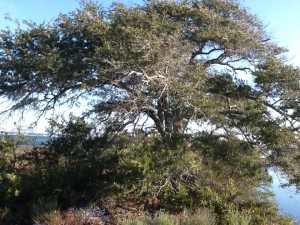
With the dunes blocking offshore winds trees can grow much larger on the back side of the island; like this live oak.

This pond supports a stand of green algae which supports many of the aquatic animals that visit here.
On this winter day I primarily saw bird life. The air temperature was 39 F and the wind was out of the north. Many of the mammals move at night and the reptiles, being cold blooded, were hibernating somewhere; the bird life however was pretty active. Many woodlands birds were out feeding on seeds and berries, herons and egrets were in the marsh hunting fish in the shallow waters, and shorebirds were picking through the beach wrack and some were diving.

This pelican is searching over Santa Rosa Sound for a fish to feed on. Photo: Rick O’Connor

This unusual drag was found between the salt marsh and the sound side shoreline. It looks like a turtle crawl but at his time of year more probable something being dragged by something.
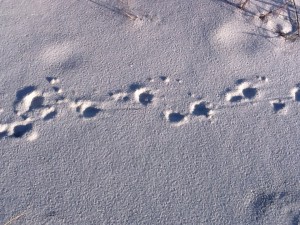
Armadillo tracks can be identified by their “tail drags”.
Salt marshes are one of the most productive systems on earth; and the target for another FLORIDA’S PANHANDLE series. Crabs, shrimp, mollusk, worms, terrapins, fish, and birds are some of the wildlife that call this place home – and maybe we will find some as this series continues into the warmer months. Today I found pelicans, herons, and egrets here eating.

A finger of a salt marsh on Santa Rosa Island. The water here is saline, particularly during high tide. Photo: Rick O’Connor
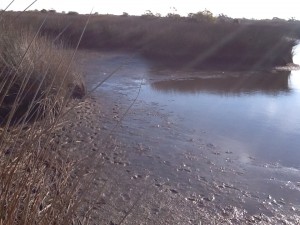
The muck of a salt marsh. This rich organic mud is very loose and the hiker can quickly sink! Notice the tracks of a predator.

Notice the low water levels typical of winter. This congregates fish into smaller pools and makes it easier for birds and mammals to catch them.
The Sound side of the island has wind but less wind than the Gulf side. The wave energy here is also lower supporting seagrass and oyster communities. Like the marsh these places are very productive; though all I really saw moving on this cold winter morning were the birds. There are two species of seagrass common to our sounds; turtle grass and shoal grass. However there have been reports of more tropical species appearing. We may find some when the water warms up. These waters support at least 100 species of fish and many invertebrates we enjoy eating.

The darker areas in the water are seagrasses. Photo: Rick O’Connor

I found this along the shore last winter. These are cannonball jellyfish.

This is a sea nettle. This species of jellyfish has a more painful sting. I only saw one of these today but saw several cannonballs.

People find this “sea foam” frequently when they visit the beach. It is formed when the winds pick up and there are nutrients in the water. It was up and down the beach today.

It is not uncommon to find dead fish along the shore after a hard freeze as we have had in recent weeks. When it warms these dead fish will attract scavengers including cottonmouths. Maybe we will see one later in the year.

There was very little trash on the island today but it was there. These pieces of debris can cause serious problems for coastal wildlife. We will discuss this issue more as this series moves on.
Well, for January we found the beach to be cold and windy. Very little wildlife was out to be viewed other than birds and the numerous tracks in the dunes, but as the temperatures warm we will see more. Take some time to visit our barrier islands and enjoy them. Until February.

by Rick O'Connor | Oct 10, 2014
In the last few weeks we have received an increase in calls about snake encounters. Most of these have dealt with small juvenile snakes folks are finding on their property, or in their homes, but we are also hearing about large ones.

Corn snakes are excellent climbers and consume a lot of rodents.
Photo: Nick Baldwin
Most of the 56 species of snakes found in the southeastern United States breed in spring or summer and this time of year people begin to encounter the juveniles from this year’s brood. The Southern Black Racer has been the most common encounter we have heard from and this is because the young do not resemble the adults at all. But panhandle residents should be aware that there are several species who do breed in the fall and the adults will be seeking each other this time of year increasing your chances of an encounter. Of those that do breed in the fall 16 can be found in the panhandle.
Three of these species are small terrestrial snakes. They would include the Florida Red-Bellied Snake, the Southeastern Crown Snake, and the Southern Ringneck Snake. These are typically less than 15” in length and move at night. They frequent the underbrush where they hunt for insects and small amphibians and are no threat to people or pets.
There are 4 species of local mid-sized snakes that are fall breeders. The Rough Green Snake, Eastern Garter Snake, Eastern Hognose Snake, and the Scarlet Snake are all very common and pose no threat to people and pets. The Green Snake and Scarlet Snake can be found in around trees this time of year and the Eastern Hognose is often confused with the Pygmy Rattlesnake. Hognose differ in that they have round pupils and an upturned nose; of course they lack a rattle as well. Scarlet snake is confused with the Eastern Coral Snake but can be distinguished but their red head (instead of black).

Gray rat snake crossing a driveway.
Photo: Carrie Stevenson
Of the 8 species of large terrestrial snakes only 2 are known to breed in the fall locally. These would be the Gray Rat Snake and the Eastern Indigo. Both of these snakes can easily reach 6 ft. in length and tend to terrify people but in reality these are both rather docile and consume a significant number of disease carrying rodents; Indigos will actually feed on venomous snakes helping to control their populations. The Eastern Indigo Snake has not been seen in the Florida panhandle since the late 1990’s and is current listed as an endangered species in our state.
We have 15 species of non-venomous water snakes in the southeastern U.S. but only 1 local is a fall breeder; the Queen Snake. This snake is found in all panhandle counties except those along the coastal portion of the Apalachicola River; Bay, Gulf, Franklin, and Wakulla counties. As a group water snakes tend to be aggressive, and some can be quite large, but they pose no danger to people and pets.
Finally the ones most are concerned with. There are 6 species of venomous snakes in the southeastern U.S. All 6 can be found in the panhandle and all 6 breed in the fall. This means that males will be out seeking females and encounters could occur. Copperheads are rare in Florida but are most often encountered along the region of the Apalachicola River. These snakes tend to be cryptic and move very little. They will release a musk to warn that you are getting to close. There are 2 subspecies of Cottonmouths in the panhandle. The Florida Cottonmouth is found in the coastal counties of the Apalachicola River (mentioned) and the Eastern Cottonmouth is found elsewhere. They prefer water but will move upland during the cooler months. They have a reputation of being aggressive but are actually no more aggressive than other snakes. Like most, they are trying to avoid you. The Eastern Coral Snake is the only neurotoxic snake in our state. This animal moves through the underbrush seeking prey, including other snakes. They are rarely encountered but are quite common.

The familiar face of an Eastern Diamondback Rattlesnake.
Photo: Nick Baldwin
Then there are the most feared of the group – the rattlesnakes. The Timber Rattlesnake is actually not that common in Florida but many travel to Georgia and Alabama during deer season where they are common. The Eastern Diamondback and the Dusky Pigmy Rattlesnakes are common here. All three species breed in the fall and could be encountered this time of year.
Many of our local snakes will den during these cooler months and some in groups. All should be aware of this when exploring stump holes and such while visiting the outdoors. Also know that on warm sunny days they may venture out to bask in the sun; another chance to encounter them.
For more information on how to handle an encounter or a snake bite visit the Escambia County Extension website ( http://escambia.ifas.ufl.edu ) or contact Rick O’Connor at 850-475-5230; roc1@ufl.edu .

by Carrie Stevenson | Sep 12, 2014
 The UF/IFAS Extension Escambia and Santa Rosa counties and Naturally EscaRosa would like to invite agritour and ecotour providers to the 2014 Agri/Eco-tourism Business Development Conference on November 5-6, 2014. The conference is geared for businesses wishing to enhance and develop their offerings.
The UF/IFAS Extension Escambia and Santa Rosa counties and Naturally EscaRosa would like to invite agritour and ecotour providers to the 2014 Agri/Eco-tourism Business Development Conference on November 5-6, 2014. The conference is geared for businesses wishing to enhance and develop their offerings.
Owners, operators and employees of u-pick operations, fresh produce markets, corn mazes, pumpkin patches, wildlife/bird watching, paddling, camping, fishing, etc. tourism businesses or those considering starting a similar business are invited to attend this event.
The conference will be an exciting blend of informational sessions, hands on activities, and an opportunity to explore local agritourism and ecotourism businesses. The conference will provide important information for new business startups as well as long established companies in the field.
The keynote speaker, Eric Eckl, will provide information on messaging and direct marketing campaigns. Other topics in the educational program include: starting a business, liability, local success stories, liability, staffing, benefits, & healthcare.
The conference will be held at Adventures Unlimited at 8974 Tomahawk Landing, Milton, Florida 32570. The conference begins at 9 am Nov. 5 and runs through the afternoon of Nov. 6, 2014. Conference registration is $25.00, to register go to: http://santarosa.ifas.ufl.edu/agritourism-ecotourism-conference/
For more information on the 2014 Gulf Coast Agritourism & Ecotourism Business Development Conference, contact Chris Verlinde (850) 623-3868 or Carrie Stevenson (850) 475-5230.
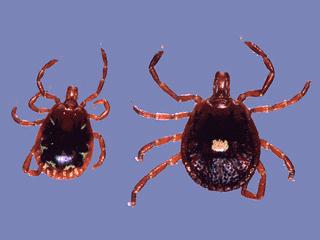
by Jennifer Bearden | Dec 13, 2013
This fall remains mild despite a couple of recent frosty mornings.

Lone Star Ticks carry Southern Tick Associated Rash Illness. Photo Courtesy of UF/IFAS Communications
With mild temperatures comes ticks. Ticks carry and transmit several diseases.
Brown dog ticks are found mainly on dogs and can carry Rocky Mountain Spotted Fever.
American dog ticks are also usually found on dogs but will also attach to other mammals and humans. They also can transmit Rocky Mountain Spotted Fever. American dog ticks can cause paralysis when they attach to the base of the skull or spinal column. Recovery usually occurs within 24 hours of tick removal.
Gulf Coast Ticks are similar to the American dog tick with larger mouthparts. They transmit a less severe relative of Rocky Mountain Spotted Fever. Gulf Coast Ticks are commonly found on the ears of large mammals such as horses and cattle.
Lone Star Tick is the most common human-biting tick in Florida. They transmit Southern Tick Associated Rash Illness which is similar to Lyme disease.
Black-legged tick, also called deer tick, is most commonly known as the carrier of Lyme disease.
Here are a few ways to prevent tick-borne illnesses:
- Remove ticks as soon as possible
- Wear light colored clothing so ticks can easily be seen
- Keep all clothing buttoned, zipped and tucked-in
- Use Repellents with 20-30% DEET on exposed skin
- Apply Permethrins to clothing and allow them to dry before wearing
- Avoid brushing against plants in tick-infested areas
- Clear brush along pathways and walk in the middle of pathway
If you are bitten by a tick or develop symptoms, contact your physician. Early diagnosis is best and makes treating tick disease easier and more effective.
[youtube=http://www.youtube.com/watch?v=tbIn_cxTlJQ]
























































